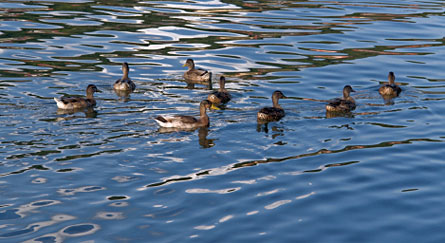Flu river
Rivers polluted with Tamiflu could help a resistant flu strain develop in birds
 |
|
Tamiflu, the primary flu-fighting drug, is getting into surface waters where ducks and other water birds may pick it up. If the birds are carrying flu viruses, which many normally do, those viruses may develop a resistance to the drug, scientists now worry. |
| iStockphoto |
What if the solution to one problem causes other problems down the road? That may be the case in the ongoing struggle to fight the flu. Flu season is almost here, which means more and more people may be taking Tamiflu in the months ahead. Tamiflu is a popular anti-flu drug that treats both seasonal flu strains and the new H1N1 flu, an unpredictable disease better known as swine flu.
But this increased use of Tamiflu may be introducing new problems. A team of Japanese scientists recently studied three rivers in Japan and found them to be contaminated with Tamiflu’s active ingredient, oseltamivir carboxylate or OC. They found the same contamination in the water discharged from local sewage plants, water that ends up in those rivers. People excreted the drug in their urine, and water discharged from the sewage plants carried it to the rivers.
Sewage treatment plants are designed to remove germs and solids from the wastes dispensed by household toilets, but many drugs can get through. OC is one of those escaping drugs.
OC in the water may be a serious problem for birds — and for people. Here’s why: The flu, short for influenza, is caused by a virus, a tiny organism that invades living cells and turns them against the body. There is not one flu-causing virus; there are many. These many viruses are constantly evolving, or changing in order to survive. They find new ways to infect people and animals, and every year new kinds of flu show up. Birds are natural carriers of many flu-causing viruses.
If a bird drinks water polluted with OC, that bird may be able to fight off the types of flu that Tamiflu treats. As a result, new flus — flus that can’t be cured by Tamiflu — may start to develop in the bird. Once a drug-resistant flu grows in the bird, that bird can pass it on to other animals. This new, stronger flu could eventually start infecting people. And that could mean big trouble, since Tamiflu would not help people fight this stronger flu..
The Japanese study was led by Gopal Ghosh of Kyoto University. Ghosh and his team collected water from two places: sewage treatment plants and the rivers that carried away the treated wastewater dispensed by the plants. They first collected samples in December of last year, when the flu season was starting. They collected more water samples in February, when the flu was bad, and collected a third set of samples later.
The scientists found OC in the sewage samples every time. They found a higher concentration in the second set of samples, from February. That’s when the flu was at its worst, and 1,738 cases were recorded in Kyoto. At the same time, in the second set of samples taken in February, the scientists found OC in the river water as well. The OC did not show up in the river in the first and third set of samples.
Scientists have known for years that sewage treatment plants do not remove OC from the water. Jerker Fick, an environmental chemist at Umeå University in Sweden, published a study two years ago that showed that most water treatment plants removed “zero percent” — or none — of the OC. In fact, Fick says, almost all the Tamiflu ingested by a human being will end up in the environment as OC.
And when the OC comes out of the sewage treatment plants, the birds will be ready. Ducks, for example, love to swim in the warm waters just downstream of those plants during the coldest months — during flu season. “I saw it myself,” Fick says.
POWER WORDS (from the Yahoo! Kids Dictionary)
flu or influenza An acute, contagious, viral infection characterized by inflammation of the respiratory tract and by fever, chills, muscular pain and prostration.
concentration The amount of a specified substance in a unit amount of another substance. The Ghosh study determined how many nanograms (one billionth of a gram) of OC was in a liter of the water they sampled.
virus Any of various simple submicroscopic parasites of plants, animals and bacteria that often cause disease and that consist essentially of a core of RNA or DNA surrounded by a protein coat.







